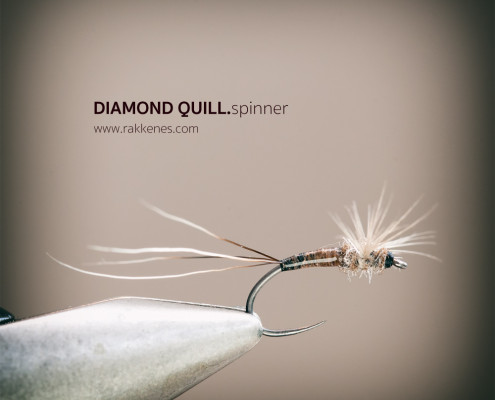THE CURVED QUILL SPINNER
The beautiful curve on this Hends BL554 caddis pupa hook gives the Curved Quill Spinner an attractive profile. Looks like a diving whale and presents its body perfectly to the feeding trout.
This is a fly that has an attractive profile in the water. It really looks like a whale up on the surface for some oxygene. The thing with the profile is that it forces the body of the fly down into the water, resulting in a crisp body profile for the fish.
When you tie this fly, start with the Badger tails. They are hard and require resolute pressure to the thread to secure the position. Fix them at the with a medium hard turn, and make harder turns as you progress forwards.
The tie-in point for the tails can be varied from the usual dry fly position, to further back. See this pattern for a variation with tails tied in at the curve of the hook.
Then do the wings. They require some training, but the moment you master the hackle technique, you’ll never go back to any other material. Search YouTube for instructional videos on how to tie-up cock hackle.
Lastly you’ll tie in the abdomen and thorax with the material of your choice. But do try Hends Body Quill and Bug Bond…
Also read the floating experiment where the tied-up hackle wings are put to the test
Hook: Hends BL 554 Size 14-16
Thread: Veevus 12/0 Black
Tail: Badger
Abdomen: Hends Body Quill – Tan, but use any color to match the spinner
Wing: Hebert Mining Bronze Cape Medium Dun
Thorax: Brown/Tan Silk dubbing, but any buggy dubbing will do
This fly is a quick tie, but the wing tankes some training to get right. But tie a few, and you’ll get the hang of it pretty fast. Use Bug Bond to create the diamond glass effect on the body.
Read more about the Hends BL 554 here
Apply floatant, and use a strike indicator when the natural light is low. A long leader and a careful approach to the fish is necessary.
Interesting reads on Spent Spinners






